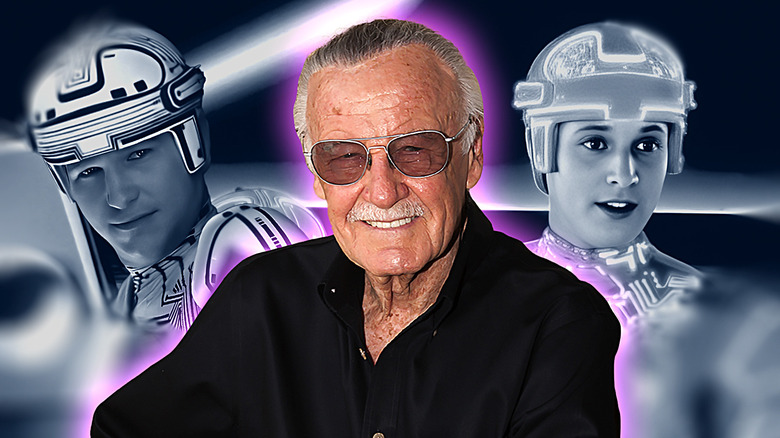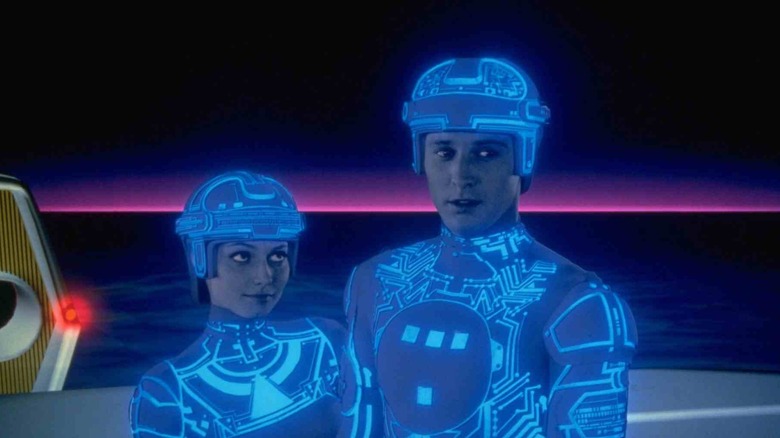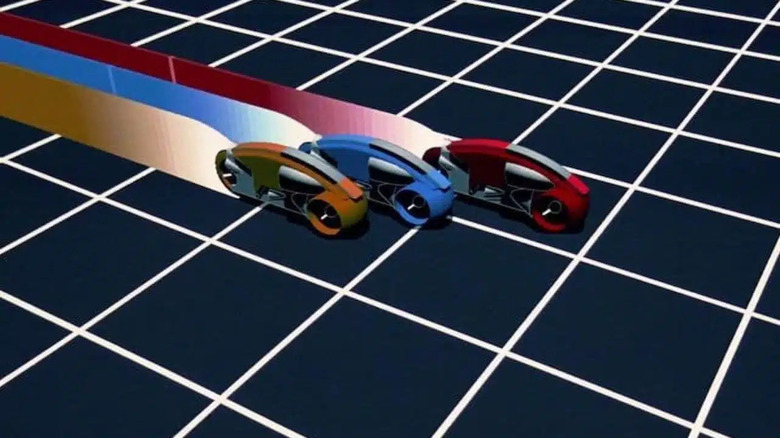How Stan Lee Shortsightedly Handed Disney Sci-Fi Classic TRON
The history of visual effects, like every other aspect of the arts, exists on a spectrum. Yet there are undeniably milestone works that push a given medium forward, whether through sheer force of popularity and influence, or through innovation, or sometimes both. "TRON," a film made by Steven Lisberger in 1982, is one of those milestone movies. Although it began as a modest success at the box office, it quickly gained a cult following thanks to its application of innovative techniques, particularly its moments of computer animation. Despite those moments only amounting to about 15 or 20 minutes of screen time, it proved that computer graphics imagery could be viable in cinema, leading to the dominance of CGI that we see in fantasy and sci-fi films today.
Yet one of the problems with innovation is that, before new technology is proven to work, most folks either can't see how it'll work, or instinctively dismiss it as something that will never work. To be fair, there are many more failed concepts in the world than brand new inventions that are successful (just watch any given episode of "Shark Tank" for proof), but sometimes rolling the dice on a daring new idea can really pay off.
Sadly, when Lisberger was shopping "TRON" around to various studios and artists, he was met with more naysayers than mavericks. One of those people who lacked the vision for where Lisberger was trying to take the film was none other than the co-creator of Marvel Comics and cameo maven, Stan Lee. Imagine: if Stan the Man had really been a True Believer in computer animation, "TRON" might've been the very first Marvel movie!
Stan Lee gives TRON the heave-ho
To be fair, it's not like Stan Lee was the only person to turn Lisberger down. As the director recalled while speaking to The Guardian in 2022:
"Quite a few established film people thought I was nuts, but I didn't know enough about how Hollywood works to know that I was attempting the impossible."
Up until attempting to make "TRON," Lisberger had been running his own company, Lisberger Studios, which specialized in commercials, opening and closing titles, and other graphic-oriented segments for various shows and films. Once Lisberger and his co-writer, Bonnie MacBird, began developing their idea in 1979 for a movie about a man who travels inside a computer and finds anthropomorphized programs fighting for freedom against a tyrannic Master Control Program, they did a ton of research on cutting-edge technologies, leading Lisberger to believe that computer animation could help make his vision a reality.
Obviously, Stan Lee was never considered someone who could make "TRON" happen in a literal sense, not being the owner of a major motion picture studio or some such thing. Yet Lee was obviously a figurehead in the world of graphic arts, and Lisberger wanted to get the man's take on his concept, showing him a demo of some computer animation. Lee's response was very New York:
"He looked at me like: 'OK kid, good luck with all that.' He was not in the least interested."
TRON finds a home at Walt Disney Studios
Fortunately, Lisberger was able to find a home for "TRON" at a major studio that was going through a rough patch at the time: Disney. Left adrift after the passing of Walt Disney in 1966, Walt Disney Pictures had allowed its animated films to take a back seat after producing so many medium-defining classics during its heyday, and, like the rest of Hollywood, had been scrambling to try and compete with the surge of sci-fi/fantasy films in the wake of the massive success of "Star Wars."
When Lisberger approached Disney with "TRON," the studio was eager to take on his wild idea, particularly because it would be made with a blend of traditional animation techniques, live-action, and this newfangled computer technology:
"It was like the castle in 'Sleeping Beauty.' Here was this amazing place, and they were insular and not really connected to Hollywood. It was a sleeping giant waiting to be woken up."
Although "TRON" didn't necessarily push Disney into a new position of power, Lisberger's observations turned out to be more prophetic than he could've known. After "TRON" helped pave the way for other milestone movies making use of CGI (films like "Young Sherlock Holmes," "The Abyss," and "Jurassic Park"), computer graphics rapidly became the norm, so much so that people began looking for the next big thing.
For Disney, that thing was de-aging, which was first attempted in, you guessed it, 2010's "TRON Legacy." Soon after that film, Disney bought Marvel Studios, and de-aged versions of Marvel characters began to crop up in those films. Who knows what Stan Lee thought of de-aging or CGI in general, but one wonders if perhaps he didn't have a little chuckle at rejecting Lisberger's pitch all those years before.


